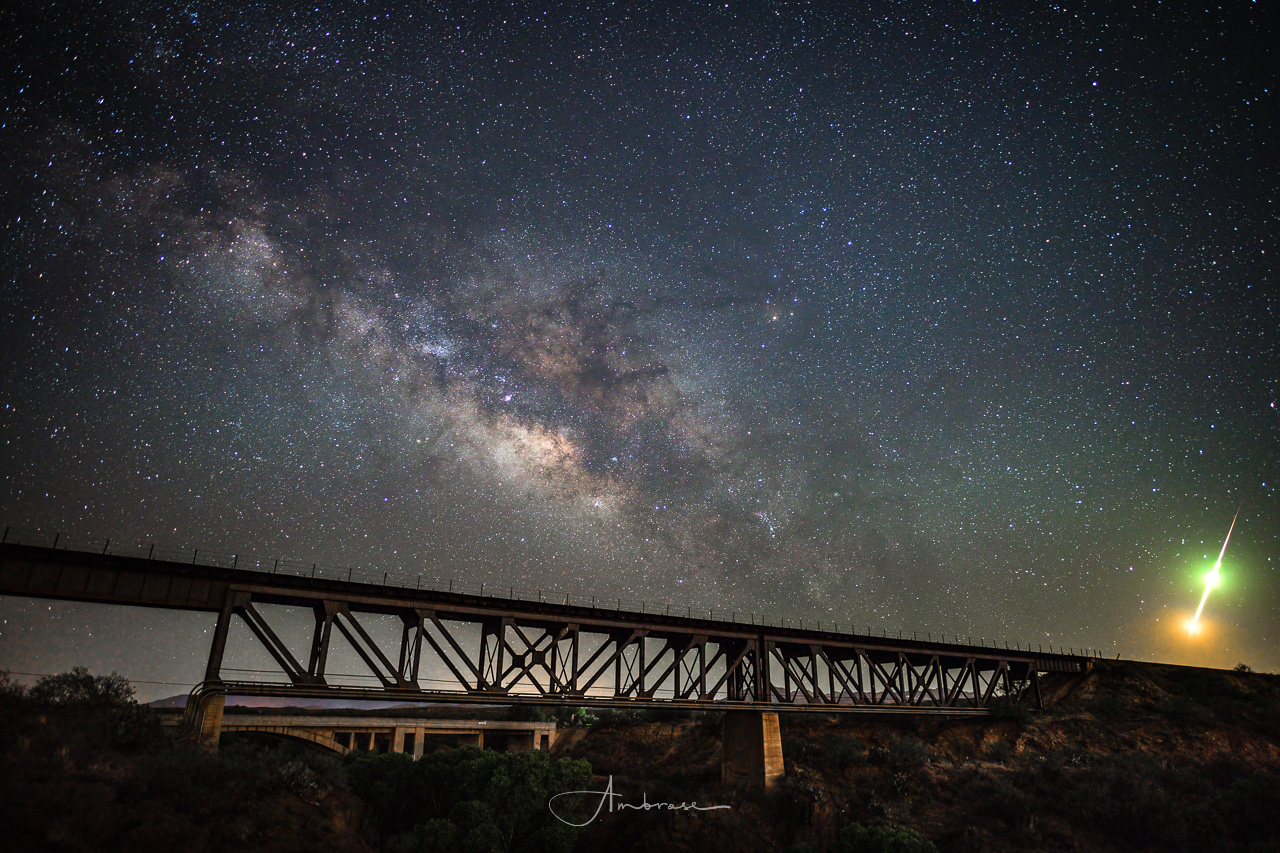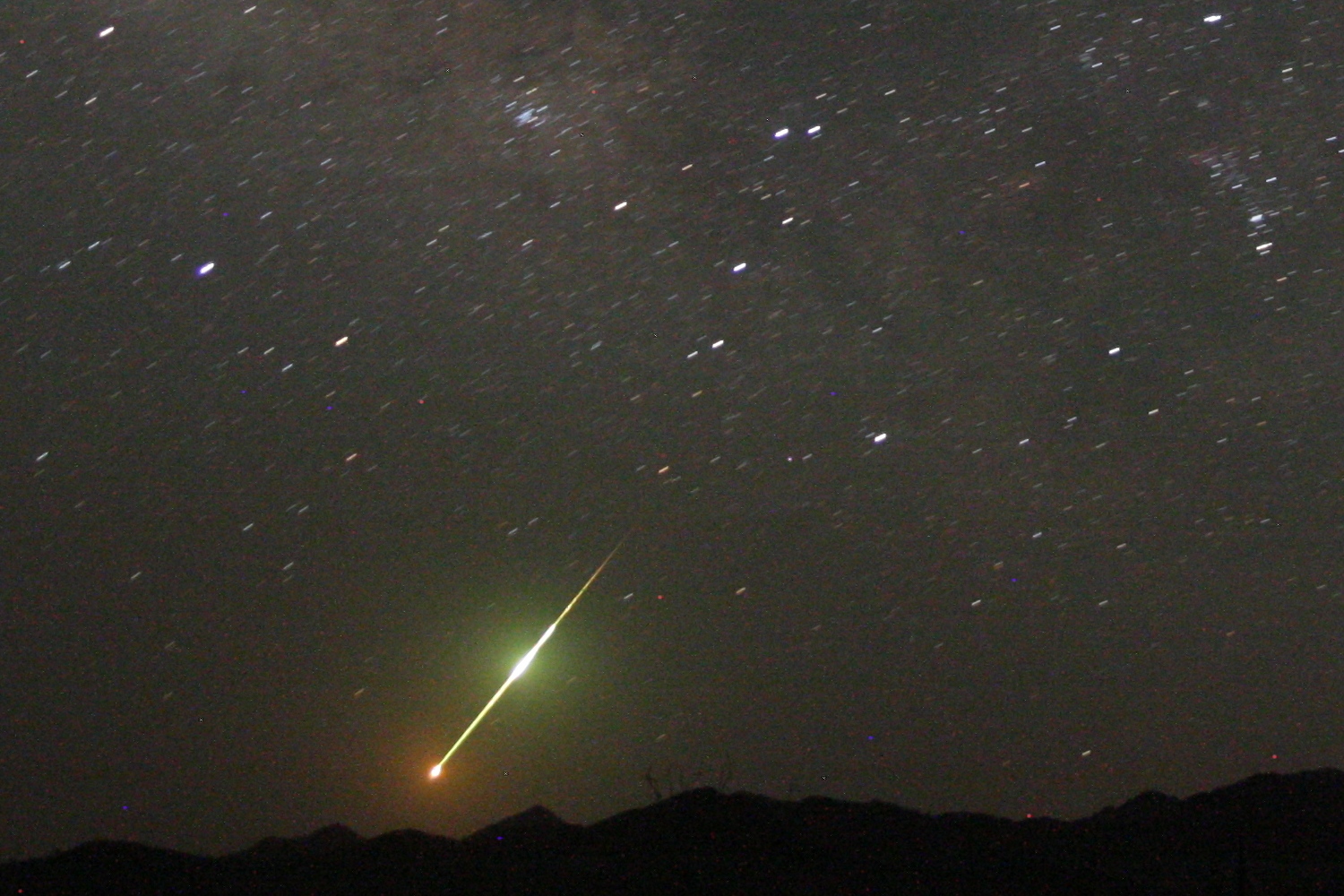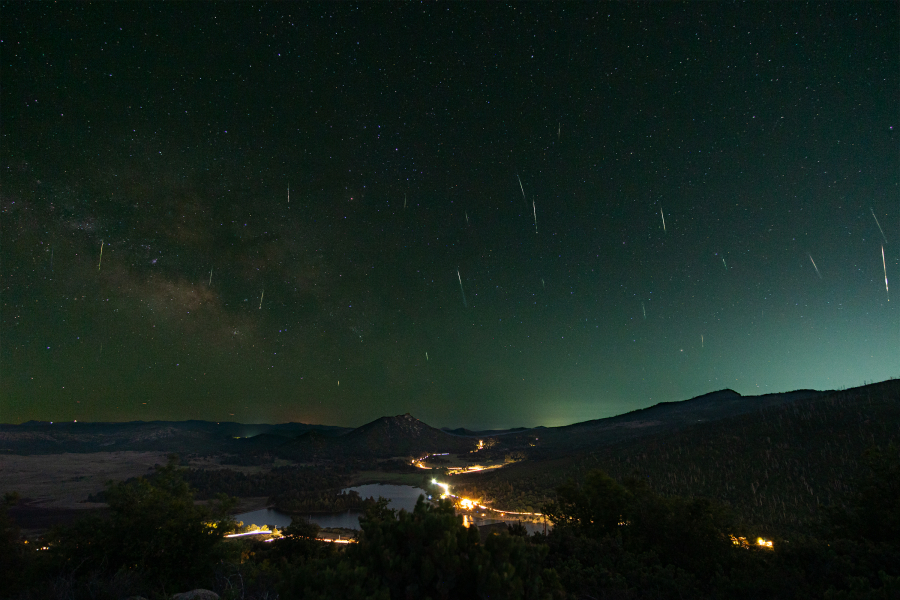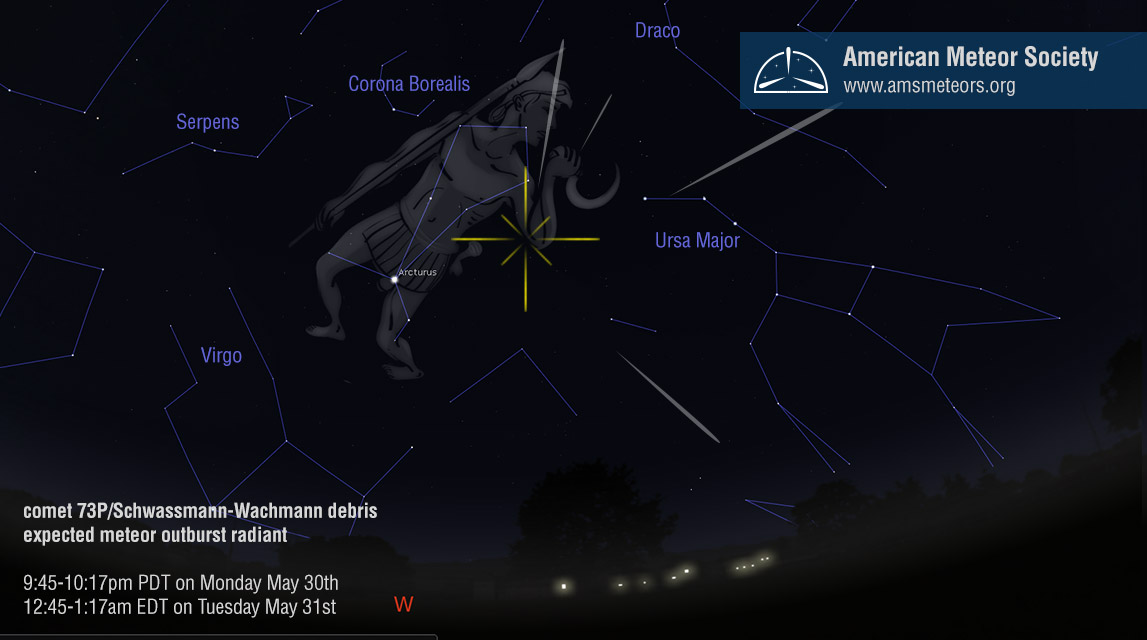


Meteor observers all over the world who had clear skies were able to witness meteors from comet SW3, which peaked between 4-5 Universal Time on May 31st. This was close to the predicted time of maximum activity and those situated under the clear skies of southwestern USA and northern Mexico had the best view. Although rates were modest, most observers who viewed from dark locations were pleased with the results. The highest hourly rates reported for these meteors so far has been around 50. I was able to count 25 per hour, but my skies were less than perfect. These rates compare favorably with medium strength annual showers such as the eta Aquariids and the Orionids. If you missed this display you have a long wait for another opportunity from this source as we do not expect such a favorable encounter again until the year 2033!

On the night of May 30/31, the Earth crosses the orbit of comet 73P/Schwassmann-Wachmann, also known as SW3. The comet itself will not be anywhere near the vicinity of the Earth but debris from a massive fragmentation event in 1995 may be there to light up our skies with meteors. SW3 will reach this point in August but meteor watchers are hopeful that the fragmentation event in 1995 sent debris ahead of the comet to be encountered by the Earth in May. Most debris ends up behind the comet forming the tail we see in bright comets. But if the velocity of the debris leaving the comet was high enough, some of this material could have also moved forward of the comet. Even if this comes to pass, we also need to hope that the debris is large enough to be visible from the ground. Most meteors we see are produced by tiny bits of rock, ice, or metal, no larger than a grain of sand. It is the tremendous velocity at which they strike that atmosphere that causes them to be visible while still high in the atmosphere. Unfortunately the debris from SW3 will be moving in the same general direction as the Earth, therefore these meteors will be toward the low end of the velocity scale. What this means is that the meteors entering the atmosphere from SW3 must be larger than normal in order to be seen from the ground.
So it sounds as if this display is highly unlikely. Possibly, but there have been meteor outbursts produced by slower than normal meteors in the past. The Bielids (Andromedids) of the 19th century and the Giacobinids (October Draconids) of the 20th century are example of meteors that were slower than normal that produced outbursts. So what do you need to know in order to try and see this possible outburst? First of all the Earth is predicted to encounter the debris from the 1995 event between 4:45-5:17 Universal Time on Tuesday May 31st. This corresponds to 12:45-1:17am EDT on Tuesday May 31st and 9:45-10:17pm PDT on Monday May 30th. The southwestern USA and Mexico are favored locations as the radiant, the area of the sky where these meteors come from, will be located highest in a dark sky. Alaska and Washington will be bathed in twilight at this time, ruining their chance of seeing anything. The same goes for the north and western Canadian provinces. The outburst may be seen from southeastern Canada and the remainder of the USA, but at a lower altitude. All of Central and South America can see this event, but the radiant will be low in the sky all but the northwest portion of South America.
The Earth will also cross two more debris fields produced by the 1892 and 1897 returns of this comet. These are predicted to occur at 16 UT on May 30th (favoring the western Pacific, Asia, and Oceania) and 10UT on the 31st (favoring western North America and the Eastern Pacific). These two debris fields are thought to be much less dense than the 1995 event, therefore little activity is expected from them.
No matter your location, the meteors will be shooting from the same location in the sky. This will NOT be from the faint star known as tau Herculis, which is why I am refraining from calling this shower the tau Herculids. Radiants from disruptive comets such as SW3 can be located in different portions of the sky year to year, depending on the location of the debris trail. The expected radiant for meteors from SW3 this year is located at the position of 13:56 (209) +28. This position is located in western Bootes, approximately 8 degrees northwest of the brilliant orange star known as Arcturus (alpha Bootis). This area of the sky is best placed near 22:00 (10pm) local daylight saving time, when it lies highest in the sky. It should be noted that the radiant is expected to be a large area of the sky and not a pinpoint. So any slow meteor from this general area of the sky can be expected to be from SW3. You need not look directly overhead as meteors may appear in any portion of the sky. They are actually more likely to appear at lower elevations in the sky since at these elevations one is looking through a far thicker slice of the atmosphere that when looking straight upwards.
If this display occurs, most of the meteors are expected to be faint. Therefore in order to see the most activity it is highly suggested that you observe from the darkest location possible. The more stars you can see, the more meteors you will see. You need at avoid city lights as much as possible. The moon will be new on May 30th so it will not interfere at all, which is most fortunate as it is easier to avoid light pollution compared to moonlight! Start your viewing session at least an hour prior to the time of the expect outburst, just in case the predictions are off. This will also allow your eyes to be fully adjusted to the dark surroundings. Try to avoid anything that will ruin your night vision such as flashlights and car headlights.
While it is fun just lying back and enjoying the scene, anyone can contribute scientifically useful data by counting the number of meteors seen during a specified period. We usually like to limit each period to 20 meteors or less so the length of each period depends on the activity. If activity is low then hour long periods are acceptable. If activity is high then you may wish to try and estimate the number of meteors visible each minute or fractions of a minute. Try to differentiate meteors from SW3 and those that come from another direction or have a faster velocity. Do not count satellites as they are totally unrelated to meteor and usually take several minutes to cross the sky. Meteor observations are accepted by the International Meteor Organization. Simply register (it’s free) or log in at www.imo.net and enter your data on their visual meteor observing form.
Predictions of brilliant comets and strong meteor outbursts are commonplace and usually end up being an non-event. This event may also be wishful thinking, giving those who publicize it another black eye. But we believe that this event has a chance of being something spectacular and that we would be remiss by not publicizing it. When viewing events such as these one should expect nothing extraordinary to happen, but certainly hope for the best!
References:
2022 IMO Meteor Shower Calendar; by Jürgen Rendtel, P 9-10
 American Meteor Society
American Meteor Society
A very interesting article! As a ham radio operator I transmit and receive signals by bouncing my signal off the meteor trail. I am always looking for meteor scatter opportunities.
Thank you for a sane, realistic, and helpful article.
Did anyone see a large meteorite or fragment on a comet last night around 11 pm over Meredith NH, with small bits behind it, very low to the earth?
Amy and All,
Check out: https://fireball.amsmeteors.org/members/imo_view/event/2022/3144 If anyone wishes to add their fireball observation, visit: https://fireball.amsmeteors.org/members/imo/report_intro/
As of 3:30 p.m., 3/30/22 radar data from NASA’s All Sky Fireball network is starting to pick up a cluster of slow meteors near the expected tau Herculid’s radiant near Arcturus.
If these are indeed from the tau Herculids shower, then I would consider this a very encouraging sign for a good show by 10 p.m. which is still ~7 hrs away.
As noted, the main reason for all the uncertainty in the potential strength of the encounter has been whether debris from comet 73p’s S/W disintegration was propelled forward and wide enough to reach Earth by the time the earth reached the comet’s orbit…and if we are already seeing an uptick, that in turn means at least some smaller debris was indeed accelerated fast enough to reach us already.
It was parts of a satellite that broke up entering the atmosphere! Wonder why it lost its orbit, but it did.
Most of Washington will be in mid to late Nautical Twilight at that time. Meteors 3rd magnitude and brighter should be visible, cloud cover permitting.
IMO observer MATBE:
Ran 145 miles E of Kansas City to find clear skies during a Thunderstorm filled night in the Midwest. Pulled over 20 miles W of Topeka at 10pm in the fading twilight and saw 4 in 10m from the Tau Herculids. 3rd and 4th mag. All near the zenith. Repositioned and had maybe 20 min from 1035 to 1055 CDT and only saw 3 more and a sporadic. One was a nice 1st mag example slicing down past Vega in Lyra. Huge mega lightning supercell high blow off cirrus took my clear skies out clear down to Corvus and Spica back to rising Scorpio so we decided to do a huge SE move of maybe 50 miles or so.
Finally got off turnpike around 25 miles N or Emporia KS and got a nice dark site off 56 hwy and had a 40 min session from 1200 local midnite to 1240am or 0500-0540UT.
Saw 13 Tau Herculids and 2 sporadic. 3 nice Tau Herculids, a -0.5 and a -1 both near 1205-1210 CDT, and at 1232 a beautiful -2 yellow slow mover straight up at the zenith moving toward the big dipper, leaving a 1 sec train. Almost all the TH’s came in pairs w lulls between them.
I am a longtime veteran observer, and my opinion is that this enhanced activity was from the two older trails Earth crossed and rates fit in well w the estimated ZHR of 14 predicted for them.
Which means probably no activity from the 95 pre-comet trail.
Huge complex of Tstorms w terrible lightning stopped us at 1240am local CDT on May 31st.
Thought I’d get this info out ASAP for those that didn’t get clear skies.
Regards,
Bert Matous
Lee’s Summit, MO
USA
Does anyone know if/when earth will pass through this same trail again?
Over time, the debris field is going to diffuse throughout the comet’s orbit, and future encounters may put on a good show?
Craig and All,
Unfortunately it appears that we will not encounter this trail again until 2098.
I was out last night from 9:45 to 10:45 PDT. I saw 13 meteors that Im pretty sure were from SW3.
They all came from the predicted radiant and were of slow velocity. Oddly they ALL travelled from south to north and most were directly over head.
Very short duration and not too bright.
Nothing over northwestern lower Michigan